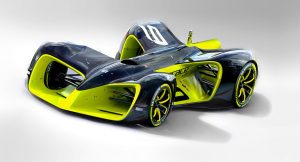
We’re all starting to get a bit blasé about self driving cars now. They were a novelty when they first came out, but even if the vast majority of us have never seen one, let alone been in one, we know they’re there and they work1 and that they are getting better with each iteration (which is phenomenally fast). But after watching the formula 1 racing, it’s a big step from a 30mph trundle around a city to over 200mph racing around a track with other cars. Or is it?
I don’t think so. We consider the problem more difficult because we are thinking of how difficult it is for a human to race – the physical fitness, concentration, hydration, reactions. The likes of Lewis Hamilton and Sebastian Vettel are driving at the limits of the engineering and regulations rather than their personal physical and mental limits, but it’s still a task that most of us will never be able to master even with the opportunity. Machines don’t get tired, reaction times are predictably fast, and they don’t need fluids to keep their brains active2.
For AI, the racing problem is fundamentally similar to a self driving car in suburbia: stay on the road and avoid other vehicles. With the track modelled as a single lane and removing some of the tolerances about how close other vehicles can be and the lack of speed limit, the AI requires many of the same skills, just a little faster…
Without a human to accommodate, the aerodynamics and build of the car can be more efficient. Sensors on the car can give a 360 degree view that a driver could never have3. Controlling the car based on this information is also a relatively simple problem4. What AI is lacking is the human edge – the hunger for the win. Human drivers often make very risky moves for big (potential) reward. Sometimes they’re heroes and other times they’re walking dejectedly back to the pits. A standard AI wouldn’t care, it would want to complete the race as quickly as possible, but would stick to programmed safety parameters. Would we ever get an AI that would cut up the inside of another car at Club corner5 to gain a place? Brake late into Adelaide corner to fend off a challenger? Drive aggressively to defend that precious 5 point lead? This is what we need, and what I think will be the hadest part of the problem – giving an AI diver the concept of risk/reward and the desire to win.
One of the huge criticisms of Formula 1 in recent years is that, at times, all the racing happens in qualifying and the races themselves can be simply 50 laps of parading fast cars6. Formula E has addressed this somewhat with a different style of racing and is also worth watching, especially as the new season has only just started. If Robo Racing is to be successful (for which it needs to be commercially viable) then it needs to be exciting – as fans we’ll want to see the cars make risky overtakes, brake late and over shoot corners. We’ll want to see something just as exciting as the human racing.
If the companies involved in the Roboraces can crack that, then we’ll have something fantastic to watch! Regardless, I’m really excited by this and am looking forward to seeing this develop and hopefully become a mainstream motorsport.
If you want to find out more, check out the Roborace website. They’re releasing videos from the 14th October on their channel so be sure to sign up for announcements. Or if you’re an Engineer with a CompSci friend – get yourself some sponsorship and create your own car – I’d love to see this inspire some people…
- Providing we follow the instructions when used outside of test environments. ↩
- Although I still cling to the romantic idea of an artificial brain being powered by a strong cup of tea 🙂 ↩
- Even if this was allowed by the regulations, a human driver could never take in all this information quickly enough to act ↩
- I say this a lot at work, and it is relative rather than actually being simple 😉 ↩
- At Silverstone ↩
- I disagree, although there are races that I’m happy I can only watch the highlights… ↩